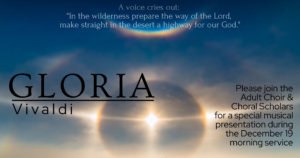
When the modern-day Vivaldi revival began early in the twentieth century, attention focused mainly on the composer’s concertos. Those were particularly interesting to scholars and musicians because of their influence on J. S. Bach. But then, in the late 1920’s their view of Vivaldi changed, when a large collection of his vocal music was discovered in Turin. Suddenly, he was much more than a composer of violin concertos. The Gloria, part of that Turin collection, received its twentieth-century premiere in 1930 and has remained the most popular of all Vivaldi’s vocal works ever since.
In addition to concertos, Vivaldi was asked to write a good deal of religious music for the accomplished musicians at the Ospedale della Pietà, the girls’ orphanage in Venice where he served as music director. In all likelihood, the present Gloria, in which all the vocal solos are for female voices, was written for the girls at the school. It is a setting of a single section of a mass, but it is almost certainly a complete work and not a fragment, since it was not uncommon to write individual mass movements for specific occasions.
The orchestration, which may have been inspired by the roster of students at the school, calls for relatively limited forces — only a single oboe and a single trumpet (with no timpani) are added to the strings — and there are only three vocal soloists. The work opens with the kind of strong motoric rhythm that is reminiscent of Vivaldi’s concertos but then shifts into the beautiful harmonic world of the Et in terra pax, a movement that wanders meditatively through unexpected keys.
The closing fugue (Cum sancto spiritu) is in a more conservative style than the rest of the work and is in fact not originally by Vivaldi. He “borrowed” it from a work by a contemporary, Giovanni Maria Ruggieri. Here Vivaldi has considerably improved the original, altering the orchestration, giving a greater role to the trumpet, and condensing Ruggieri’s double chorus to a single four-voice chorus. The Ruggieri fugue may be an unexpected choice for the ending of this work, but Vivaldi seems to have been so impressed with it that this was the second time that he used it. The first was a rather different adaptation in one of his earlier works, which was also a setting of the Gloria.
-Martin Pearlman
